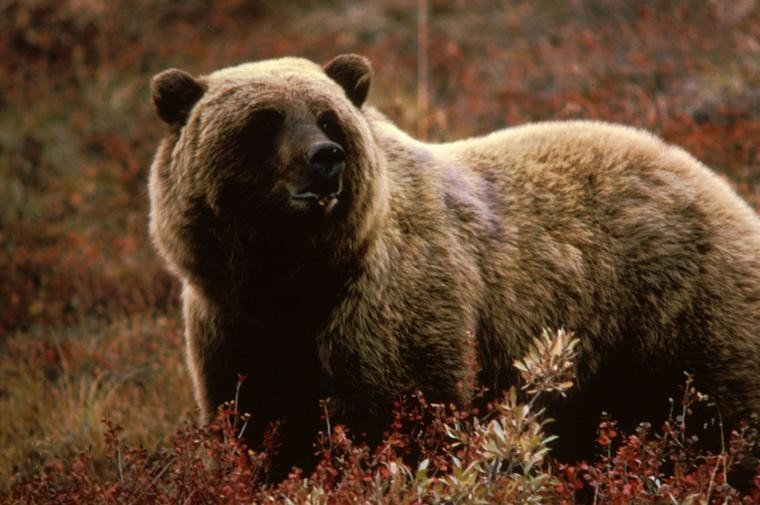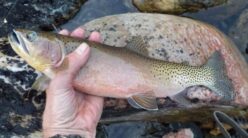A few dozen members of the public attended the first public meeting Tuesday night at the College of Eastern Idaho concerning the proposed Idaho grizzly hunt.
Idaho’s proposed hunt — in which a single, hopefully male, grizzly would be taken — follows the official decision to delist the Yellowstone grizzly under the Endangered Species Act. Wyoming also plans to hold its first grizzly hunting season in decades, while Montana has opted not to commence a hunting season this year.
The number of bears which can be taken in each state is determined by what portion of the Yellowstone grizzly’s habitat lies in each state. Since Idaho has only about 8 percent of the habitat within its boundaries, the Gem State has far fewer potential hunting tags allocated to it under the delisting agreement.
Staff from the Idaho Department of Fish and Game laid out their proposal for the hunt, the units in which hunting could take place and the rules that would have to be followed by the hunter who draws the tag. Both the use of dogs and hunting over bait — common means of hunting bears and other large predators in some places — would be banned.
Hunting would take place largely in Fremont County, with small portions of northern Teton County included.
The proposal, which isn’t a final plan and could be altered, is expected to come before the Fish and Game Commission on May 10.
Fish and Game Regional Bear Biologist Jeremy Nicholson went over the timeline of the recovery of the Yellowstone grizzly, from near extinction in the early 1970s, when there were fewer than 200 bears estimated to be living in the ecosystem, to today when there are an estimated 718.
“Range extension and population recovery is a success story,” Nicholson said.
Nicholson said over the last decade, bear numbers in the Greater Yellowstone Ecosystem have been relatively stable, indicating the area was at or near carrying capacity for the grizzly.
“We’ve successfully recovered another endangered species,” said Wildlife Assistant Bureau Chief Toby Boudreau.
But the grizzly still inhabits only a tiny fraction of its historical range, which once included virtually all of North America west of the Mississippi from far northern Canada to southern Mexico. Today, only a handful of grizzly populations remain in the contiguous United States, and the Yellowstone segment is the second largest. The largest population is in northwestern Montana on the Canadian border.
Regional Wildlife Manager Curtis Hendricks said the proposal is for the single bear to be taken in a controlled hunt that is organized along the same lines as other controlled hunts in Idaho. The tag will be issued through a lottery system rather than through an auction system, as is done for exclusive hunts in some states. The major difference, Hendricks said, is that in 2018 an application for the grizzly hunt won’t prevent applying for another controlled hunt.
There are two main reasons, he said. First, grizzly delisting plans are the subject of federal litigation, so it’s possible that the hunt could be blocked by the courts.
Second, because of the late date at which the drawing will take place, many who have already applied for other controlled hunts could be excluded.
A major concern for groups such as the Center for Biological Diversity, one of a host of groups suing the federal government to block delisting, is if the hunter who draws the tag accidentally takes a female rather than a male grizzly. While wildlife managers argued the interstate agreement regulating grizzly hunting allows flexibility in the case a female is killed — either by working with neighboring states to make sure the overall number of females taken is proper, or by counting excess female mortality against future years — Center Senior Attorney Andrea Santarsiere said the plan doesn’t go far enough to protect females.
“Saying they can figure it out later if they kill too many female grizzly bears is completely irresponsible,” said Santarsiere, who is based in Victor.
Hendricks said concerns that hunting will endanger the recovery of the grizzly are misplaced.
“We haven’t put this much energy into getting grizzlies delisted to do anything that would endanger that,” he said.
Trophy hunting of the grizzly has also been strongly opposed by Native American tribes around the nation, including the Shoshone-Bannock Tribes, which issued a news release reiterating its opposition late Thursday.
“No grizzly bears will ever be hunted on Shoshone-Bannock lands, and my tribe will oppose any attempts to hunt grizzlies in our recognized ancestral homelands,” tribal Chairman Nathan Small said in the release.
The release argued the decision by the U.S. Fish and Wildlife Services and wildlife management agencies in Wyoming, Idaho and Montana to allow trophy hunting violates principles of tribal sovereignty and the American Indian Religious Freedom Act.
“The tribes consider the grizzly bear to be a brother/uncle to our people, and there are ceremonies and songs for this animal,” said councilman Lee Juan Tyler in the release. “We hold the grizzly bear in high regard, and harvesting of this animal will affect our tribe and all other tribes as well.”



